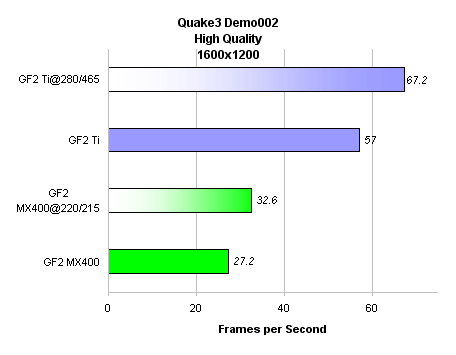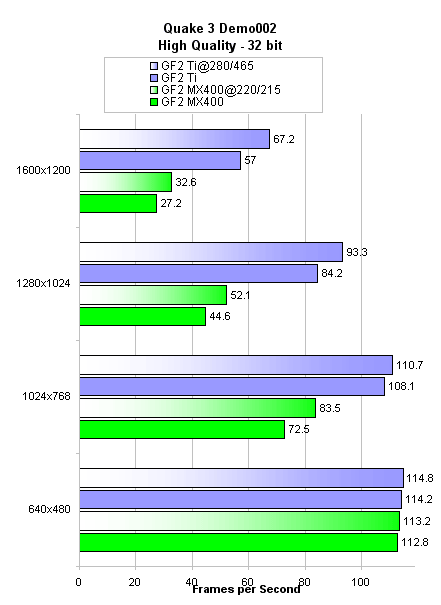
Playing
Quake3 at 1600x1200 ( 32 bit ) is simply not an option
for the MX400. The Geforce2 Ti delivers more than
twice the frame rate the MX400 has to offer. And even
the impressive 20% performance gain from overclocking
wont help the MX400 perform acceptably in this very
high resolution.
The GeForce2 Ti also gains quite a bonus from overclocking.
An added 18% definately wont hurt. Overclocking the
Geforce2 Ti enables it just to go beyong the 60fps
mark, which to a so-called "hardcore gamer"
is the absolute minimum frame rate to be considered
"playable.:

The performance of the MX400 and the Geforce2 Ti is
shown above with varying resolutions. At 1024x768
( 32 bit Color Depth) the MX400 begins to trail the
Geforce2 Ti. With less than half the available bandwidth
of the Geforce2 Ti, the MX400 simply can't keep up
with the Geforce2 Ti as the resolution is cranked
up some more.
Going from 640x480 to 1024x768, the MX400 suffers
a drop in frame rate of 35%! An overclocked MX400
however cuts back the loss to 26%. The raw power of
the Geforce2 Ti however enables it to lose only 5%
and only 3% when overclocked.
As the resolution goes up to 1280x1024 ( from 1024x768
), the MX400 suffers another huge loss in frame rate
( 39% ). Overclocking it really helps as a hefty 16%
performance is gained. The Geforce2 Ti on the other
hand, suffers a 22% decrease in frame rate when the
resolution was bumped.
Finally when the resolution is upped the for the last
time, the MX400's performance is down to 27.2 frames
per second. A full 39% decrease from the previous
resolution ( 1280x1024 ). The powerful Geforce2 Ti
too, begins to buckle as it loses 32% of its performance.


